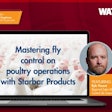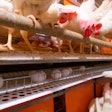Keeping pesky and disease carrying insects out of the poultry barn requires a multi-pronged approach.
This approach, called integrated pest management (IPM), uses management changes, physical traps and chemical interventions to knock down bug populations and keep them down. In a WATT Poultry Chat interview presented by Central Life Sciences, Kyle Vincent, regional sales manager at Central Life Sciences, spoke about fly control specifically and using Starbar products in an IPM program.
Austin Alonzo: What types of flies are common in poultry barns and how do they impact business?
Kyle Vincent: Yes, as mentioned, flies are definitely a concern at poultry operations. They can be a stress factor to both the birds and to employees, which which can really hurt feed efficiency. It can also hurt employee efficiency. But as mentioned earlier, flies can transmit diseases. We know this. Salmonella, E. coli, even avian influenza, so it's definitely important that we get a good handle on fly control in poultry operations.
In layer operations, one of the main flies that we find is the house fly. And that's a big vector for disease in those layer operations.
Austin Alonzo: So what is integrated pest management? And how can it be applied to poultry operations?
Kyle Vincent: Integrated Pest Management (IPM) is really a fancy way to say we're going to use a multi-prong approach, right? There's not one magic product or magic management thing that's going to fix everything. So we have to use all the tools in the toolbox. And really, the most important part to a successful IPM program is three parts. It's planning the program, it's implementing that plan, and then it's evaluating the results.
So, as we look at an IPM program, we want to plan and by planning, I mean, we want to get eyes on the operation that way we can identify if there's any cultural or management practices that need to be implemented or possibly changed. That would be vegetation around the facilities, or litter management or waste management.
Then, as we get a more narrowed focus, we can look at target areas that maybe need a chemical intervention to get adult fly populations either captured or killed. And then an even more narrow focus would be bio-rational implementation, this is going to be natural predators to fly larva, or chemicals that go after fly larva to stop development.
So, we do that plan that's tailored to that specific operation. And then that plan gets implemented. Okay, that's step two implementing that IPM program. And then probably the most important part is the evaluation at the end. And we don't want to leave this up to someone's interpretation to say, I think it's better I think it's not better, we actually use things like flyspeck cards, which you would change at regular intervals, so that you can visually see the fly droppings, either reducing or maybe not changing. And then we can also use things like sticky traps also changed at irregular intervals.
That way you can see the progression from start to where you are today. Is it getting better? Is it not getting better? Is it getting worse? If it's getting worse, not getting better then we go through the process again.
We go back to the plan. Do we need to alter a chemistry or a practice? Then we implement the new plan and we evaluate again, because we want to see that we're seeing reduction of flies. That's the ultimate goal.

Kyle Vincent (Courtesy Central Life Sciences)
Austin Alonzo: What are some recommended products from Starbar a grower can use as part of an IPM program for their poultry operation.
Kyle Vincent: Starbar really has a wide range of products. And they're kind of broken into categories. So I'll go through those with you.
First off, we have high level products, and by high I mean up near the ceiling. That's where flies go to land and rest. So we use brightly colored sticky traps up high.
Some examples would be the Fly Stik, the Stik Jr, the EZ Trap, the Lure-Fly ribbons. All of these products go up high to capture flies when they're going to land and rest.
The second category is mid level products. And by mid level we mean four to six feet off the ground. That's where flies are flying and mating. So, when they're in that mid level we like to use odor pheromone traps that draw the flies in. These are a dry attractant that is activated by water and when those flies come into that liquid because of the pheromone they get stuck in there and they can't get out.
Now, some examples of those would be your Captivator, Terminator, Flyrelief bags, the Trap 'n' Toss. Some are reusable. Some are throw aways. They're all the same, they bring the flies in with that pheromone and they capture them.
The third category is down low. Down low is where flies go to feed. So we use our baits down low. Down low, we have DuraStrike, Cyanarox, Golden Malrin and Quikstrike. All four of these are four different active ingredients that are four different classes of chemistry. The reason that's important is because flies can build resistance to different chemistries. So from one season to the next, or even possibly mid-season in one fly season, we can rotate chemistries away from what you've previously used into something different, because we don't want flies to build resistance.
So that's part of your planning, and your implementation: What chemistry has been used? Let's get you on something new, make sure that it's effective. We also have Quikstrike bait spray. This is the same chemistry as the Quikstrike scatter bait, only much more versatile because it can be sprayed on vertical surfaces.
So, in poultry facilities where sometimes your options are limited for granular scatter bait, the bait spray can be a very good option. Down low we also have Exhalt. That is a water dissolvable granule that's designed to stop larva development. So this product would be applied either dry or wet to litter. And that's going to stop larvae from developing. So not only are we getting the adults with the fly baits, we're also getting the juveniles with the insect growth regulator (IGR) in Exhalt.
The fourth category of products we like to call: In, on and around. Basically that means in the facilities, on animal or around the facilities. So these are mostly liquids. And they're different chemistries also. Because, again, one chemistry might not work as well as a different chemistry for you based on what you've been doing.
So, some examples of these would be your Crop Spray, your Lambda, your UL-100 EC, all of them have slightly different labels different concentrations of the active plus a synergist. Some of them can be used on animals overtop of birds, or possibly fogging facilities in-between birds being present, or even outside of the facility if you need to get a knockdown of the live fly population.
So all of these products from these different categories can be put together in an IPM program. It's important that we follow the labels on these products so that they're used properly. But if done properly and put together by a professional, a good IPM program with Starbar products can really get you an effective fly control.
Austin Alonzo: Alright, Kyle, well, thank you very much for joining us today. Was there anywhere where people can learn more about these products?
Kyle Vincent: You can easily learn more about Starbar products at our website, starbarproducts.com, including where to buy, and this will help find a distributor near you or retailer near you. And you can also find information on who your local Starbar representative is if you need to have that on-farm consultation so that we can help you build an IPM program.
This transcript edited for length and clarity.

















